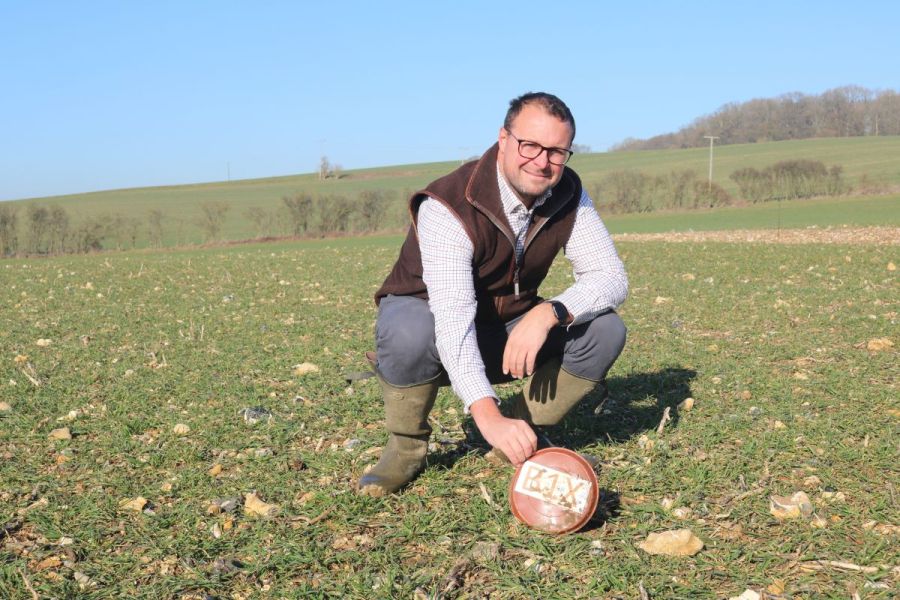A landrace wheat, never grown before in the UK, may provide the route to slug-resistant wheat. CPM visits a specialist farming company taking part in the quest and reports first-year results of the farmer-led trials.
“The trial has opened our eyes to a multitude of ways we can reduce the impact of slugs.”
By Tom Allen-Stevens
In the bright, early spring sunshine, the pale green of the Watkins 788 landrace wheat sits in striking contrast to the darker green of the Gleam winter wheat that surrounds it.
Jamie Melrose stoops to inspect a few plants. “Right from establishment it’s looked well, but the Watkins really is motoring on now. If it wasn’t for its bright green hue, you’d barely be able to distinguish it from the Gleam. That makes these two wheats quite different from the Blackman wheat, even though both the Blackman and the Watkins were drilled at the same seed rate – 60% of what we used for the Gleam.”

A yearning to explore the outer reaches of research and innovation prompted Andrew Francis to set up TEAM Ag.
He gestures to the next-door tramline. Occupying its width are two square plots of a third wheat, this one bred by independent UK plant breeder John Blackman – a pre-commercial line of KWS Santiago x Graham. It looks to be a pace behind the Watkins, which similarly takes up two 36x36m plots within the field.
But it’s not their growth rate that’s of interest. Both these unusual wheats may be resistant to slugs. For the Watkins 788, this came about through a public-funded study of the landrace variety that came from central Asia almost 100 years ago.
It’s part of a farmer-led trial co-ordinated by BOFIN (British On-Farm Innovation Network). Ten “Slug Sleuths” – farmer members of the network – are growing plots of Watkins 788 and comparing it with their farm standard. All of the plots were carefully monitored for slug activity and grazing damage by the farmers during establishment last autumn.
The Blackman wheat has a very different story that’s brought it to this field near Hitchin in Hertfordshire, farmed by AT Bone & Sons. The line was one of 30 pre-NL1 multiplications established in autumn 2021 by John on alluvial, heavy boulder clay near Cambridge. Nearly all the lines were obliterated by slugs, with just this one appearing relatively unscathed. That left just enough seed for four of the Sleuths to put it to the test, alongside the Watkins.

The Gleam (left) looks on a par with the Watkins 788 (centre), despite being drilled at a lower seed rate, with the Blackman wheat (right) some way behind.
Jamie wanders over to one of the 12 slug refuge traps he’s placed within the plots and inspects it for activity. “None here, and it’s been the same since we established this crop last autumn – I’ve barely seen a single shredded leaf,” he reports. “That’s unusual, because we specifically chose this site, in a crop following oilseed rape, because it’s a haven for slugs. But I don’t think their absence is down to the wheat varieties we’ve established.”
Previously farm manager for AT Bone, Jamie has now joined TEAM Ag (UK). The acronym stands for Transformational Estate and Agricultural Management and the company was set up by Andrew Francis late last year, with partners Kiryon Skippen and Jason Noy, to supply specialist services to UK estates and farms.
On-farm trials are one of those services, and Andrew brings into it 30 years’ experience from his previous role as farms director of the Elveden Estate, a 9500ha farming business based near Thetford in Norfolk.
“At Elveden, we constantly asked ourselves how we could do things differently. Typically we’d take standard farm practice, double it, halve it and explore the outer reaches,” says Andrew.
Increasingly Elveden built a reputation for cutting-edge field-based research, becoming a Strategic Potato (SPot) farm as part of AHDB’s Farm Excellence network, as well as a LEAF (Linking Environment And Farming) Demonstration Farm.
“We were keen to work with research partners to develop novel technologies and techniques,” continues Andrew. “One example was utilising biofumigant crops for PCN. What were the possible unintended consequences of confining gas underground? We wanted to explore the limits to truly understand the effect on soil-borne mycorrhizal fungi and other beneficial microbes.”
The public-funded project brought together PES Technologies, who have developed an in-field tool that measures microbial biomass, with academic partners, working with Elveden. It brought Andrew a yearning to explore further this approach to research and innovation, and TEAM Ag was set up.
“We want to combine academic with on-farm knowledge, improve networks and apply these to novel technologies to catalyse that partnership. While there may be many farmers and farm managers who want to benefit from this, few can afford the headspace to make it happen, which is where TEAM Ag comes in. We want to be part of collaborations that remove the blockers to on-farm improvements in productivity,” he says.
Andrew cites as an example how the day-to-day running of an arable farm can get in the way of the pursuit of innovation. “Many of us have lived that enthusiasm at the start of an on-farm trial. Then it gets to the busy spring and summer periods and the monitoring or the focus lapses and the outcomes are compromised. That’s where TEAM Ag steps in to take responsibility of the trial and bring it to fruition.”
That can take any guise, from day-to-day trials logistics to strategic business support to bringing in specialist agricultural R&D concerns. “Farmers are fantastic innovators and flexible in their approach. What we aim to do is provide the support they require without being prescriptive, to retain that flexibility.”
A change in cultivation practice, for example, will be unique to any farming system, he points out. “Farmers rely on proxy measurements to gauge their progress. These don’t take account of managing dry periods on a light-land farm or the landlord/tenant relationship. So let’s design the tools to measure soil structure and the effect of cover crops to ensure the path taken is the best informed.”
So why the interest in slugs? “Throughout my farming career, I’ve worked on silt farms with OSR in the rotation. We’ve progressively reduced cultivations and as we have, the impact of slugs has proved a blocker to improvements in productivity. And yet all we have to manage this impact is one active ingredient, applied hit-and-miss through pellets,” notes Andrew.
“What drew us to this project is that it takes a totally different approach. It may take many years before we have a slug-resistant wheat, but if we don’t take a long-term view to managing slugs, we will never achieve the right outcome. And what we’re learning along the way is invaluable.”
Jamie has kept in touch with the other Slug Sleuths through WhatsApp, trading information on everything from prevalence of beetles and their role in slug control, to trial design and layout, to the growth habit of this unusual wheat.
“On the face of it, the absence of slugs means we’re no closer to finding the slug-resistant trait,” says Jamie. “But the trial has opened our eyes to a multitude of ways we can reduce the impact of slugs, and the tools we can rely on to validate our approach as we develop it. That’s progress, so I’m looking forward to what we learn in future years.”
This article was taken from the latest issue of CPM. Read the article in full here.
For more articles like this, subscribe here.
Sign up for Crop Production Magazine’s FREE e-newsletter here.




